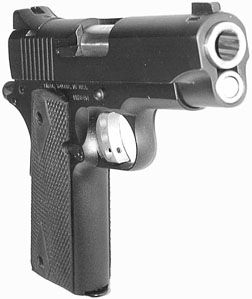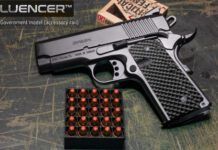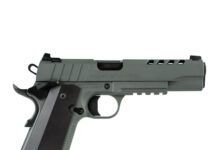
A large group of dedicated gunnies believe the very best carry pistol is a lightweight .45 Commander, as pioneered by Colt. Today, there are numerous clones of that gun available, and even Colt’s offers it in more than one variant. The whole idea is portable power that is light enough that you’ll always have it with you. Some favor the slightly smaller Officer’s Model, but we like combining the Commander slide with the Officer’s frame. Colt’s calls this combination the Concealed Carry Officer’s Model, or CCO.
All three guns in this report have the shortened “Commander”-length slide and light frames, but only two of the test guns have the full-size grip. These are the Kimber Pro Carry II (about $780) and Smith & Wesson’s new SW1911 Sc (MSRP $1029). We also look at one of our all-time-favorites, Colt’s CCO, this one set up as the “Gunsite Pistol.” With that famous shooting-and-training facility’s name on the gun, we expected premium function and price. In the latter, we were not disappointed, because the gun retails for around $1,400. Function, however, turned out to be problematic, as we detail more fully below.
All three pistols had aluminum-alloy frames and steel slides. All had beavertail grips and extended thumb safeties, none of them ambidextrous. All had fixed, highly visible dovetailed sights fore and aft, and of course all were .45 ACPs. Two of them came with two magazines, but the Kimber came with three. The CCO magazines each held six rounds; the Kimber’s, seven; and the S&W’s, eight. With those details established, let’s now take a closer look at each gun individually:
[PDFCAP(1)]
This gun was pure business with its matte-black finish and black-rubber grips. We checked to see if the gun was adequately deburred, and it passed with flying colors. Nothing snagged hand or holster, and frankly, all three were not bad in this respect. This was in glaring contrast to a Commander tested two years ago, which could actually cut paper with its sharp edges. The Kimber’s front-sight base matched the slide contour, but was not pinned in place. None of the three had the front sight pinned.
Our test shooters had mixed feelings about the rubber grip panels. Once the hand was perfectly in place these grips gave good control, but it was hard to slide the hand that last little bit to perfect the grip. The Kimber did not have forward slide serrations, which in this case we missed. It had no magazine extensions, which we didn’t miss. There was no barrel bushing, the tapered barrel being fitted to the slide itself. The rear of the chamber had a small notch to serve as a loaded-round indicator, and with a round in the chamber, a small red area on top of the extractor was visible.
The driftable rear sight was locked in place by a set screw, the same setup used on all three guns. The Kimber had a Videki-type trigger, long enough to suit us. So did the S&W, but the Colt had a shorter one. This Kimber Pro Carry II had a well-contoured beavertail that let our thumb ride the safety lever, and this thumb position incurred no failures to fire. Ditto the CCO, but S&W has not learned its lesson, which we’ll detail later. All the Kimber’s controls were normal 1911 and all worked perfectly, with the proper amount of feedback to the shooter. The mainspring housing was checkered polymer, but there was no roughening on the front strap. The Kimber’s slide was a quarter-inch shorter than the other two.
The trigger pull broke at about 5 pounds. Like the other two guns, the sight picture was close to perfect, but there were no visual aids, neither white dots nor night sights. The Kimber didn’t seem to have a lot of glitz, which was refreshing. It was time to shoot it.
We [PDFCAP(2)] with Hungarian MFS 230-grain ball, with our new handload using a 200-grain SWC cast bullet, and with Cor-Bon’s zippy 185-grain JHP load. The Kimber had one failure to feed with the second magazine-full. This was easily fixed with a tap on the back of the slide, and didn’t happen again. If we haven’t said it recently, you need to test your own self-defense handguns by shooting several hundred rounds of your chosen ammo. You should have zero failures along the way. The more you test, the better you’ll be prepared. If the gun fails in any way before firing at least 200 rounds, fix the problem and start counting again from zero. We cannot shoot our test guns enough to verify they’ll always work, and expect a break-in period that could extend to several hundred rounds. Some manufacturers specify a break-in, but most don’t. We consider a gun to have a problem if it repeatedly fails in some respect. We don’t consider it a problem if a tight new gun slips up during the first few rounds fired in it, but we will mention these.
The Kimber shot everything fairly well, with no truly outstanding nor any truly foul groups. Function was as good as you’d want. We would have liked a trigger pull a pound less, and if we owned this gun would change it. We’d also add night sights to any and all of the three test guns (our preferred colors are two orange rear dots with a green front one).
[PDFCAP(3)]
This all-black pistol had some distinct changes from an earlier stainless-slide version owned by one of our staff. Our staffer’s pistol has a rib on the slide. This one was smooth. This CCO had a short trigger. We like longer triggers, but can’t say we were troubled by this one. The slide had forward serrations, but also had the original-design slide-spring cap, which permitted the “old style” of press checking. The CCO had normal-thickness checkered rosewood grip panels and excellent “dehorning” of all surfaces. As with the Kimber, the beavertail let us work the trigger with the thumb riding the safety.
Perhaps the best thing about this fine CCO was that it recalled the grand old days when the inside of a 1911 did not have the firing-pin-intercepting plungers, levers, springs, linkages, and pins. This CCO had the simple Series 70 firing system. Congratulations to Colt for working with the folks at Gunsite to remove all that extra crap, and resurrecting the clean original design.
The CCO grip was short, but we could get all our fingers onto it. The only penalty came during reloading, when it was necessary to raise the little finger of the firing hand to ensure full seating of the new magazine. There were no unnecessary magazine extensions. Extensions make an unobtrusive grip bigger. Learn how to reload and you won’t need extensions. The hammer-spring housing was serrated polymer, and the front grip strap had vertical serrations. The CCO had a relief cut into the bottom of the trigger guard, which got the gun lower in the hand.
We pulled the gun apart to inspect the guts (easily done without tools), and loved the clean design. There was a groove machined into the center of the barrel ramp leading to the chamber, which is supposed to help feed certain bullet shapes. One thing we have never liked is the open-topped slot in the frame for the magazine follower. We’ve always thought a hole there instead of a slot would give a stronger frame. All three test guns had a notch instead of a hole. Reassembly of the CCO was a cinch. We liked being able to take the gun apart and put it back together without tools, a rare scenario today. Fit and finish were excellent, and the black finish seemed very durable.
On the range we had one failure to feed when the gun was brand new and another along the way, but it ran perfectly for most our test. The trigger pull broke at 4.5 pounds and had a little creep. We’d have preferred a slightly lighter pull but could live with this one. We could fire the gun about as fast as either of the other two, but it kicked noticeably more, and the Cor-Bon ammo was not fun. Accuracy was a touch better than with either of the other two. All shots landed about two inches above aim point at 15 yards, which suited us just fine, and groups ran around two inches. In short, the gun was just right. There was something about the CCO that endeared it to us. It looked right, felt right, and had all the stuff it needed and nothing extra. We were all set to add night sights and call it a great handgun, but then we discovered a severe safety failing.
The CCO could be fired, we found, without touching the grip safety, which is one reason why this gun was so easy to fire with our thumb held high. Extra force on the trigger, sometimes as little as ten pounds, caused the trigger to slide past the grip safety and let the hammer fall. This is not allowed. The grip safety is there for a reason, and this one did not work. No matter how hard we pressed the triggers on the other two guns, they would not override the grip safety. This condition might be easy to fix, depending on the actual fault with the parts. But for now, we cannot recommend this gun.
[PDFCAP(4)]
Smith has done a great job of fine-tuning its 1911 pistol in the short time it’s been on the market. Our Commander-length “Sc” had a whole lot going for it, including great sights, good-looking checkered wood grips, the neat external extractor, a smooth black finish that was mighty tough, near-perfect dehorning, extended safety, and a decent beavertail. But wait a minute…. Remember our test of the full-size SW1911, in which some of us could not make the trigger work with our thumb held high, riding the safety? This new Smith had the same dread disease. Our cure for the full-size gun was to send it to master pistolsmith Ned Christiansen at his Michiguns shop. Ned found that he, too, could not make the gun fire all the time. His cure was to (invisibly) recontour and refinish the beavertail. We have brought this problem to Smith & Wesson’s attention, but nothing has been done about it so far. Not all shooters are bothered by it, but clearly some are. As we took pains to point out, neither of the other two guns showed this tendency. The problem is actually caused by the hand’s web pressing too hard against the underside of the beavertail, which then resists being compressed into the firing position.
But if you find you can fire it every time, the SW1911 Sc is a good gun, we thought. Fit and finish were flawless. It fed and ejected properly with everything we tried. The white dots helped us find the sights faster. We liked the longer magazine release (a feature shared by Kimber), and the eight-round mags. We didn’t like the sharp magazine extensions. We preferred the Smith’s checkered wood to the Kimber’s rubber. We liked the forward slide serrations. We did not like the trigger pull of nearly 6 pounds. The gun had a firing-pin lock similar to those on Series 80 Colts, and they do nothing good for the trigger. We also dislike 1911s that require tools to disassemble. This one required a bushing wrench (provided), but we’d swap the slide-spring rod for a normal bushing.
On the range we found the new, light Smith did reasonably well with everything, but did best with our new handload, putting the 200-grain SWCs into 2-inch-average groups. All loads struck essentially where the gun looked at 15 yards. We had no problems firing the SW1911 Sc rapidly as long as we had a good grip on the gun. It fed, fired and ejected perfectly. Smith & Wesson is now well into the 1911 game.
Gun Test Recommends
• Kimber Pro Carry II, $780. Buy It. We could not fault this gun in any way. If you don’t like the rubber grips, change ‘em. Some will not be happy with the gun’s takedown, which requires a thin pin thrust into the recoil-spring rod. We thought we’d see poor accuracy with the no-bushing barrel, but it worked well, and there were fewer parts in this design. The extractor was a bit odd. It was outside of the slide yet used the rear slide hole of the original design. We liked getting three magazines with the package. You might want a touch of trigger work, but we thought this was a pretty good gun as it was, and a decent value.
• Colt CCO Gunsite Pistol, $1400. Don’t Buy. Because of its smaller size, lighter weight, and slightly better details, we were more favorably impressed by the CCO than by the other two. We felt the extra price was well worth paying for a clean, compact, carefully thought-out design that did everything we wanted it to. But it was faulty. One of its safety devices did not work, so we had to reject it, much to our regret. If this gun worked perfectly, it’d be all the self-defense handgun you’ll ever need, and it would be Our Pick, but it has a problem we can’t overlook.
• S&W SW1911 Sc, $1029. Conditional Buy. If we can’t always make a gun fire, we can’t give it a clean bill of health. But that can be fixed, and might not be a problem for you. The Smith’s black finish looked good even after our firing tests, as did the Colt’s finish. The Kimber’s finish seemed to lack durability, but of course cost less. We’d change the Smith’s beavertail or reshape it, reduce the trigger pull, opt for night sights, and get rid of the magazine extensions. If you can live with its (for us) questionable beavertail shape, the SW1911 Sc might be perfect for you. It’s a major advancement for S&W in the field of carry guns, and could easily be made into one of the best.
Also With This Article
[PDFCAP(5)]






























